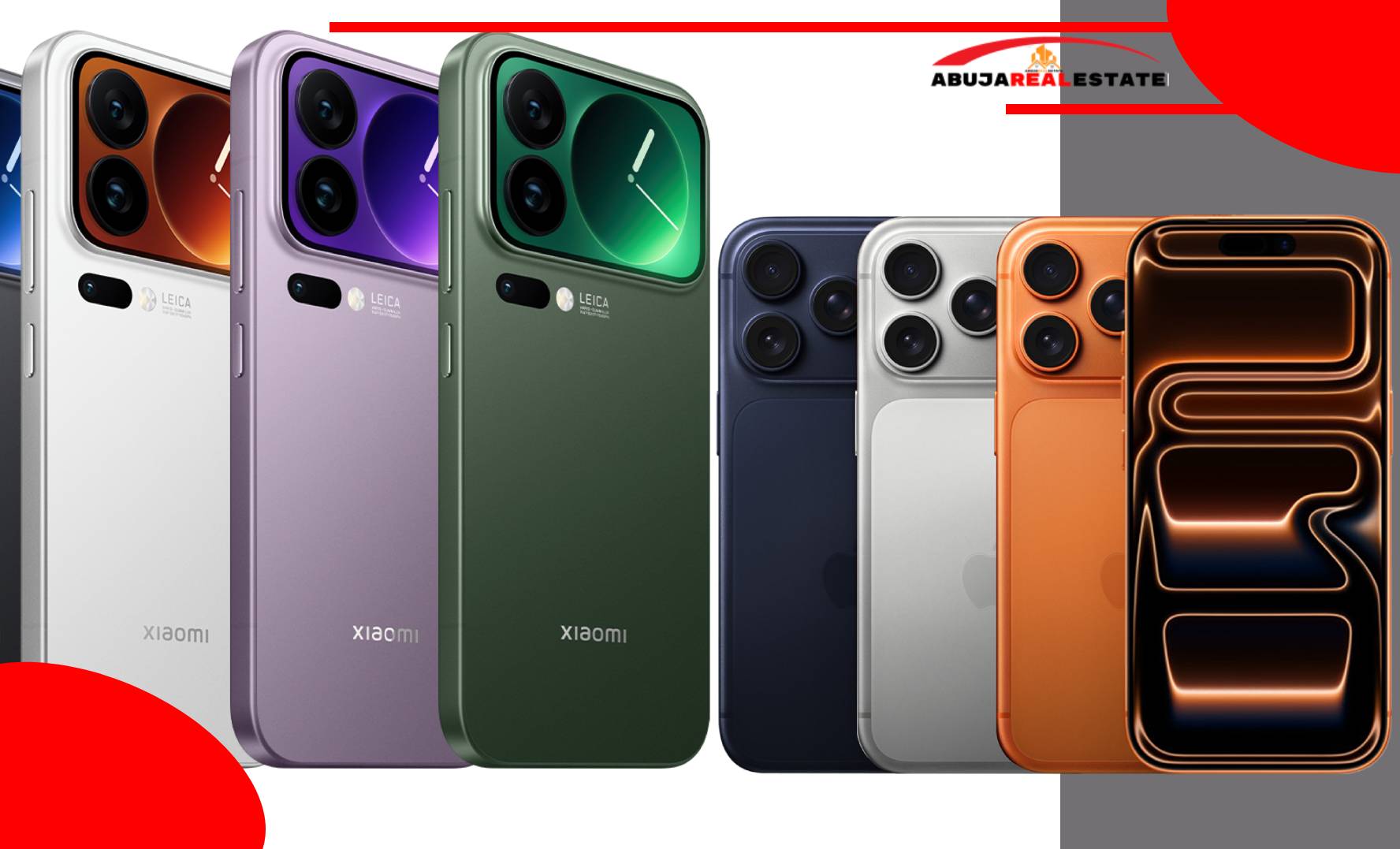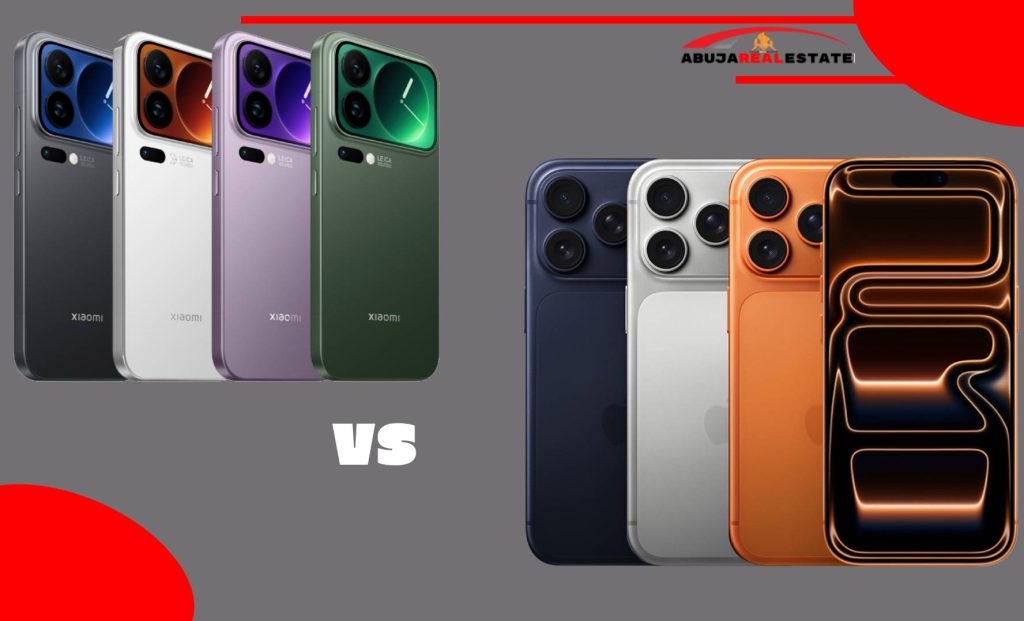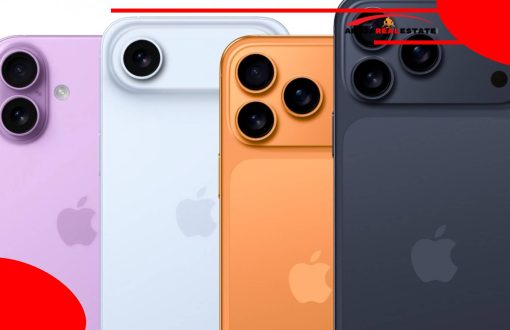Xiaomi 15 Pro vs iPhone 17 Pro Max: Specs, Camera, Storage & Quality Compared

The smartphone world never sleeps. Every year, new flagships redefine what “premium” means. In 2025, two giants — Xiaomi 15 Pro and iPhone 17 Pro Max — are leading the race. Both phones bring cutting-edge hardware, next-gen cameras, and blazing performance, but they do it in very different ways.
Read Also: iPhone 17: 10 Crazy Features No One Is Talking About
In this article, we break down Xiaomi 15 Pro vs iPhone 17 Pro Max across every major category — design, display, camera, battery, software, and more — so you can decide which one truly fits your lifestyle.
Xiaomi 15 Pro vs iPhone 17 Pro Max: Quick Comparison
| Feature | Xiaomi 15 Pro | iPhone 17 Pro Max |
| Chipset | Snapdragon 8 Elite (3 nm) | Apple A19 Pro (3 nm) |
| Display | 6.73″ LTPO AMOLED 120 Hz, 3200 nits | 6.9″ Super Retina XDR OLED 120 Hz, 3000 nits |
| RAM / Storage | 12 GB RAM / up to 1 TB | 12 GB RAM / up to 2 TB |
| Camera | Triple 50 MP (wide, ultrawide, telephoto) | Triple 48 MP (wide, ultrawide, periscope telephoto) |
| Battery | 6100 mAh – 90 W wired / 50 W wireless | 5088 mAh – 40 W wired / 25 W wireless |
| OS | Android ( HyperOS ) | iOS 26 |
| Build | Glass + Metal / IP68 | Titanium + Ceramic Shield / IP68 |
At a glance, Xiaomi offers more raw power and charging speed, while Apple focuses on integration, camera processing, and long-term value.
Design and Display
Build Quality and Aesthetics
The Xiaomi 15 Pro features a polished metal frame with curved glass on both sides, giving it a luxurious hand feel. It’s IP68 rated, so it can easily withstand dust and splashes.
Meanwhile, the iPhone 17 Pro Max continues Apple’s design legacy — sleek titanium edges, matte glass back, and Ceramic Shield protection on the front. It’s both elegant and durable, with improved grip and scratch resistance.
Both phones feel premium, but Apple edges ahead in refinement and durability.
Display Quality
Both devices feature top-tier displays with LTPO 120 Hz refresh rates.
- Xiaomi 15 Pro: 6.73″ LTPO AMOLED with 3200 nits peak brightness, HDR10+ support, and ultra-narrow bezels.
- iPhone 17 Pro Max: 6.9″ Super Retina XDR OLED with 3000 nits brightness and ProMotion technology.
In simple terms — Xiaomi delivers slightly higher brightness and a sharper contrast profile, while Apple focuses on color accuracy and consistent tone mapping. Both are stunning, but iPhone still sets the standard for true-to-life color.
Performance and Hardware
Under the hood, both flagships are absolute powerhouses.
Processor and Speed
- Xiaomi 15 Pro runs on the Snapdragon 8 Elite chipset, built on a 3 nm process. It’s designed for performance and gaming, with improved AI efficiency.
- iPhone 17 Pro Max uses the new A19 Pro chip — Apple’s most powerful processor yet. It offers unmatched single-core performance and extreme efficiency thanks to its tight integration with iOS.
For gaming and multitasking, Xiaomi feels lightning fast. But for sustained performance, app optimization, and long-term stability, the iPhone takes the crown.
RAM, Storage, and Connectivity
Both devices come with up to 12 GB RAM. Xiaomi offers UFS storage up to 1 TB, while Apple’s NVMe SSD-like storage goes up to 2 TB — ideal for creators capturing ProRes video or 8K footage.
Connectivity is equally advanced:
- 5G (sub-6 + mmWave)
- Wi-Fi 7
- Bluetooth 6.0
- NFC and Ultra-Wideband (UWB)
Xiaomi even adds an IR blaster for controlling household devices — a small but useful perk.
Camera Comparison
The camera system is often the biggest decider for buyers — and here, both phones are exceptional.
Rear Cameras
- Xiaomi 15 Pro: Triple 50 MP setup (main + ultrawide + telephoto) with Leica optics and AI enhancements.
- iPhone 17 Pro Max: Triple 48 MP system (main + ultrawide + periscope telephoto) with LiDAR sensor and Smart HDR improvements.
Low-Light Performance:
Apple’s computational photography delivers sharper, cleaner results at night. Xiaomi counters with larger sensors that capture more light and detail.
Zoom & Versatility:
The iPhone’s periscope lens provides up to 8× optical zoom, while Xiaomi offers similar range with Leica-tuned clarity. Both perform superbly, though Apple’s image consistency is more natural.
Video Recording
Apple remains unbeatable in video — supporting ProRes, Dolby Vision HDR, and cinematic mode. It’s ideal for professionals.
Xiaomi, on the other hand, lets you record in 8K video, use manual modes, and adjust color profiles freely. It’s a creator’s dream for flexibility.
If you shoot vlogs, Apple gives you ready-to-use quality; if you love tweaking settings, Xiaomi gives you freedom.
Battery and Charging
Battery Capacity
- Xiaomi 15 Pro: 6100 mAh battery
- iPhone 17 Pro Max: 5088 mAh battery
Despite a smaller capacity, Apple’s iOS efficiency often narrows the gap. However, Xiaomi’s larger battery lasts longer during heavy use like gaming or video recording.
Charging Speed
Xiaomi is the clear winner here:
- 90 W wired charging → 0 to 100% in under 30 minutes.
- 50 W wireless charging.
Apple remains conservative:
- 40 W wired and 25 W wireless (MagSafe/Qi2).
If you’re always on the go, Xiaomi’s fast charging is a lifesaver. Apple focuses more on battery health and longevity.
Software and User Experience

Operating System
- Xiaomi 15 Pro: Ships with Android 15 + HyperOS — smooth, feature-packed, and customizable.
- iPhone 17 Pro Max: Runs on iOS 26 — fast, secure, and incredibly stable.
Android gives you flexibility — custom themes, third-party stores, advanced settings. iOS provides simplicity and unmatched optimization.
Apple also promises 5-7 years of updates, while Xiaomi usually guarantees 3-4 years of Android upgrades.
Ecosystem and Integration
If you already use Apple products (MacBook, Watch, AirPods), the iPhone 17 Pro Max fits seamlessly into your ecosystem. Handoff, iCloud, FaceTime, and AirDrop make daily life effortless.
Xiaomi integrates well with other Android and smart-home devices, and its HyperOS is becoming more unified across tablets, TVs, and IoT gadgets.
Privacy and Security
Apple continues to prioritize on-device data processing and strict app permissions. Xiaomi has improved security significantly, but Android still allows more freedom — and with that comes more responsibility.
Pricing and Value
Xiaomi has always been aggressive on pricing. Expect it to cost hundreds less than the iPhone 17 Pro Max for similar hardware.
However, iPhones typically retain resale value better and enjoy longer update support. If you’re budget-minded, Xiaomi offers incredible value. If you want investment-grade reliability, Apple remains king.
Who Should Buy Which?
- Buy Xiaomi 15 Pro if you want:
- Faster charging & bigger battery
- Higher brightness display
- Better price-to-performance ratio
- Freedom to customize Android
- Buy iPhone 17 Pro Max if you want:
- Longer software support
- Better ecosystem integration
- Industry-leading video quality
- Higher resale value
Both are winners — it just depends on what matters most to you.
FAQs
Q1: Which phone has better camera quality?
iPhone 17 Pro Max delivers more consistent and natural results, especially in low light. Xiaomi’s 50 MP Leica camera produces punchier, more customizable images.
Q2: Which charges faster?
Xiaomi 15 Pro — its 90 W charger easily outpaces Apple’s 40 W limit.
Q3: Which has longer battery life?
Xiaomi’s larger 6100 mAh battery lasts longer under heavy use, but Apple’s software optimization narrows the difference.
Q4: Which phone is better for gaming?
Both are excellent, but Xiaomi’s Snapdragon 8 Elite and cooling system make it slightly better for extended gaming sessions.
Q5: Which will get more software updates?
iPhone 17 Pro Max — Apple devices usually get updates for 5 to 7 years, compared to Xiaomi’s 3 to 4.
Q6: Which offers better value for money?
Xiaomi 15 Pro offers more hardware for less money, while iPhone 17 Pro Max provides longer value, resale strength, and ecosystem stability.
Conclusion
The Xiaomi 15 Pro vs iPhone 17 Pro Max battle shows how far smartphone innovation has come. Xiaomi delivers unmatched charging speed, display brilliance, and customization freedom, while Apple masters software polish, ecosystem harmony, and long-term reliability.
If you want a performance-packed flagship at a lower cost — go Xiaomi. If you prefer timeless stability and premium ecosystem experience — go iPhone.
Note: This article is based on current research and available information. We’ll update it as new details emerge. If you found it helpful, please like and share the post!


